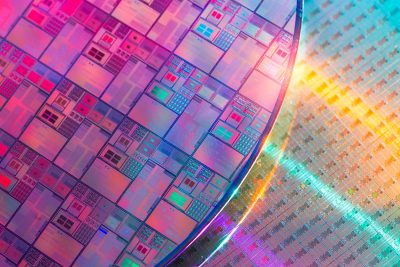
HRL Laboratories Aims at Unprecedented High-Frequency Performance in Gallium Nitride MMICs Based on Traditional Silicon Semiconductor Fabrication Techniques
HRL Laboratories’ ENIGMA Project to Monolithically Integrate State-of-the-Art Silicon Multi-Metal Backend Process with Gallium Nitride Transistors for Next-Generation Monolithic Microwave Integrated Circuits

ENIGMA will address a gap in technology between the compound semiconductor MMIC industry and the silicon RFIC industry. Getty Images
MALIBU, Calif. April 24, 2023— HRL Laboratories, LLC, is developing Efficient GaN Integrated G-band Monolithic Arrays (ENIGMA), a project funded by the Defense Advanced Research Project Agency (DARPA). ENIGMA will address a gap in technology between the compound semiconductor monolithic microwave integrated circuit (MMIC) industry and the silicon radio-frequency integrated circuit (RFIC) industry.
Semiconductor device fabrication entails two key processing flows known as front-end and back-end fabrication. The front-end refers to the process of building the transistors. The back-end comprises fabricating metal interconnects, passives (capacitors and resistors), and transmission lines. Gallium nitride (GaN) has enabled huge advances in the front-end to produce MMICs featuring record-breaking output power and efficiency due to the vastly superior combination of breakdown voltage and electron velocity. However, compound semiconductor back-end processes are crude relative to silicon RFICs and typically only feature two metal layers for interconnect and transmission lines. The result is large bulky designs that cannot meet the density requirements of next-generation multi-antenna arrays at high frequencies.
“Currently, US Government needs are for very dense, high-speed transistors that specifically target 220 GHz (G-Band) frequency, which GaN is ideal for,” said Georges Siddiqi, HRL co-principal investigator on ENIGMA. “This is also the point where the current back-end approach to compound semiconductor fabrication starts to fail. The goal of ENIGMA is to combine the optimized transistors of GaN compound semiconductors with the optimized back-end processes of silicon-based RFICs. With this approach we will unlock better performance while keeping the chip physically small.”
Siddiqi went on to say the program goal is to demonstrate ultra-compact (680 μm square) 220 GHz (G-band) MMICs and tightly integrate them into a heterogeneous 3D stack. Monolithically integrating a multi-metal back-end on GaN also takes advantage of its inherit survivability and power density over other III-V solutions, and enables dense large-element G-band arrays due to the superior heat management of GaN on SiC.
According to HRL co-principal investigator John Roderick, “The goal is to push GaN performance and integration density up to G-band frequencies by utilizing traditional silicon RFIC design techniques, which are enabled with a monolithic 7-layer metal backend that features thick ‘analog’ copper layers. This new capability has tremendous advantages in terms of data throughput, operational frequency, integration density and thermal management. III-V technology back-end features have been inferior for many years, but this new back-end capability will allow designers to leverage commercial silicon RFIC design strategies in next generation GaN MMICs.”
This material is based upon work supported by the Defense Advanced Research Projects Agency (DARPA) under Contract No. HR0011-22-C-0123. Any opinions, findings and conclusions or recommendations expressed in this material are those of the author(s) and do not necessarily reflect the views of the Defense Advanced Research Projects Agency (DARPA).
HRL Laboratories, LLC, California (hrl.com) pioneers the next frontiers of physical and information science. Delivering transformative technologies in automotive,aerospace and defense, HRL advances the critical missions of its customers. As a private company owned jointly by Boeing and GM, HRL is a source of innovations that advance the state of the art in profound and far-reaching ways.
Media Inquiries: media[at]hrl.com, (310) 317-5000